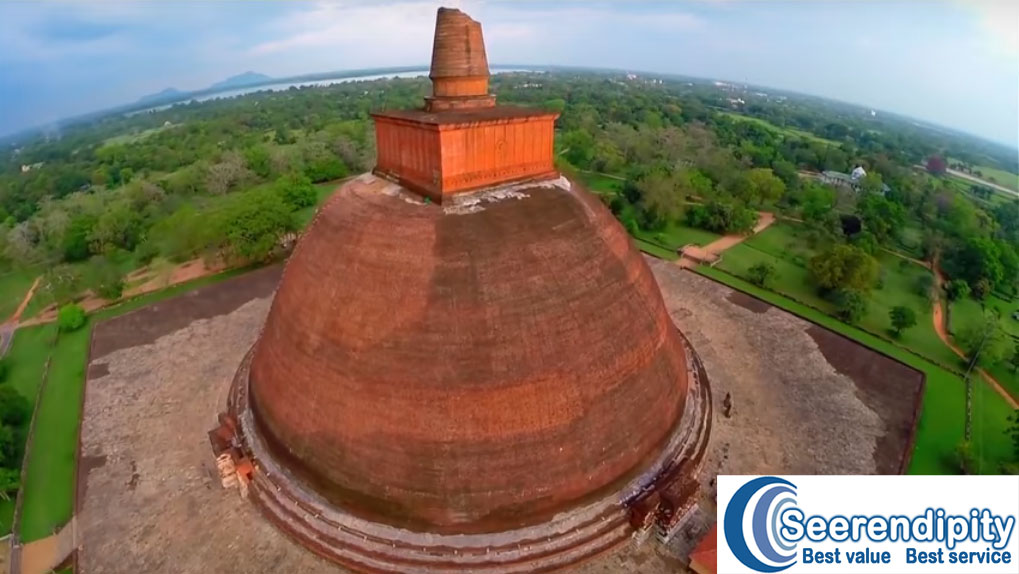Stupa an essential part of the Buddhist temple
Dagoba or stupa is an essential element of every Buddhist temple in the world. The stupa had been built since the advent of Buddhism on the island in the 2nd century BC. In this article, we are mainly discussing these stupendous constructions.
Spotting Stupas in Sri Lanka
It is not necessary to take a Sri Lanka tour and visit historical cities in the cultural triangle to spot stupas. The stupa is a wayside tourist attraction in Sri Lanka and travelers can encounter this fascinating historical monument everywhere in Sri Lanka. However, most historical Stupas such as Thuparama dagoba (2nd century BC) are to be encountered on a trip to the Cultural triangle of Sri Lanka.
Pyramid as an ancient construction
Pyramids are some of the most popular ancient constructions in the world. The biggest pyramid in Giza (Pyramid of Khufu) is the most ancient of all seven historical world wonders too. These historical attractions are well known around the world and attract tourists from every corner of the world.
According to Egyptologists they were built as tombs for the Egyptian dynasty known as Pharaoh. Probably there is no one in the world, who has not heard the word “pyramid” at least once in their lifetime. So much is known about pyramids but, aren’t there any other historical construction that comparable to pyramids? You may think No!
Buildings comparable to Pyramid
There had been other advanced civilizations during the time of Pharaoh in many other places in the world. Those other civilizations had also managed to build gigantic constructions such as Pyramids. But, most of those ingenious works are not known or are least known to most people in the world. For instance Dagobas in Sri Lanka. They are built for a very similar purpose to pyramids but with a religious background.
Construction of stupas by ancient Kings
The kings and queens of ancient Sri Lanka had a great devotion to the religion and it made them spend a large number of resources to build gigantic Dagobas.
These constructions were done with superior quality; therefore most of the dagobas are still in very good shape, even after thousands of years. Archaeologists believe that these ancient constructions are far better than some of the modern constructions and they would survive for many thousands of years in the future.
Most ancient stupas of Sri Lanka are to be found in the cultural triangle of Sri Lanka. Most known Stupas of Sri Lanka such as Jetawanarama, Abhayagiriya, and Thuparama, sit within the borders of Anuradhapura. Therefore, venturing on a cultural triangle tour is the best way to see ancient Stupas.
5 popular tours to visit Sri Lanka stupas
Venturing on the Sri Lanka land tour package is the best way to visit Stupas in historical cities in Sri Lanka. Usually, most Sri Lanka round tour packages include a visit to cultural monuments and temples. Perhaps you have booked only a Sri Lanka beach tour package, but you don’t need to be disheartened and think that you may not able to visit important tourist places in Sri Lanka. Local tour operators such as Seerendipity offers a large number of one-day tours as well as 2 days Sri Lanka trips to the important tourist attraction of Sri Lanka.
1. Sri Lanka 1 day tour to Kandy.
2. Sri Lanka 2 days tour to Kataragama temple with Galle and Yala national park
3. Sri Lanka heritage trip 2 days to Sigirya, Dambulla and Polonnaruwa.
4. 3 Days Sri Lanka cultural triangle tour with a complete circuit of Sri Lanka cultural triangle ( Anuradhapura, Sigiriya, Polonnaruwa, Kandy and Dambulla).
5. 6 days Sri Lanka culture cocktail tour with Anuradhapura, Polonnaruwa, Sigiriya, Dambulla, Kandy and Colombo.
Stupa most impressive attraction in the historical cities
Today Stupa is the most impressive attraction in many archaeological sites in the country. These dome-shaped constructions are known as dagobas on the island. But some other nations call them Stupa, Tupa, or Pagoda.
Stupa has a similar function to Pyramids; they are constructed to deposit reliquary. Dagobas are always built on an elevated rounded platform. The devotees can access Dagoba from all four directions.
What is the Purpose of a stupa?
Usually, the ancient Dagobas were built with a relic chamber in the body of the construction. The Dagobas were built to deposit the relic of Buddha or relics of some other important Buddhist monk. The inner wall of relic chambers had been beautifully decorated with religious paintings.
Valuable materials such as gold, silver, gem stones had been used for the decoration purposes of the relic chamber. The state ruler and selected other important people were allowed to enter the relic chamber.
Archaeologists have been able to discover materials such as inscriptions, statues, and murals, even silk clothes have appeared during the excavations in ancient Dagobas.
Ancient engineers were careful to build these domes on very solid foundations, making them available for many thousand years. Some of the dagobas were built in the third century BC and they are still been venerated.
Jetawanarama dagoba: the biggest stupa in the ancient world
The biggest dagoba of ancient Sri Lanka was known as Jetawanarama and it was built by King Mahasen (276-305). It had been the biggest dagoba of the ancient Buddhist world. Jetawanarama Dagoba, which was 400 feet in height and it was as big as the second pyramid in Giza.
During the excavations at Jetawanarama, archaeologists discovered the foundation of the dagoba, which is 27 feet thick. Abhayagiri Dagoba also located within the Anuradhapura world heritage site is also a huge dagoba built during the Anuradhapura kingdom. Ruwanweliseya was another most important stupa and one of the biggest on the island that was built in the second century BC by King Dutugemunu.

